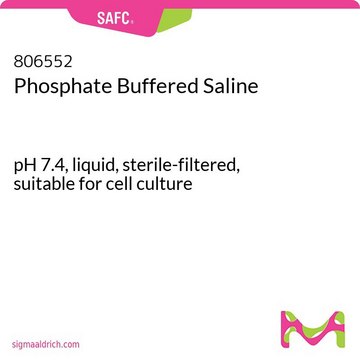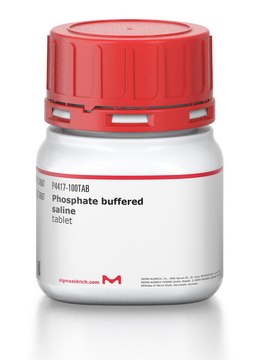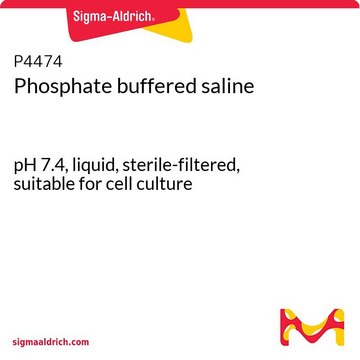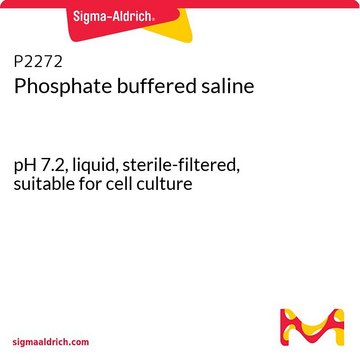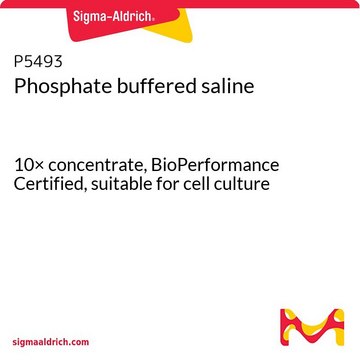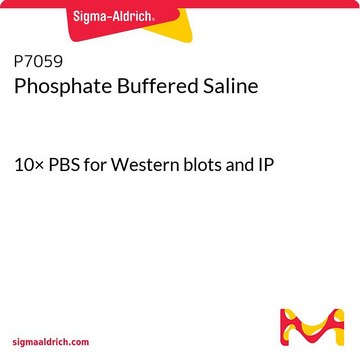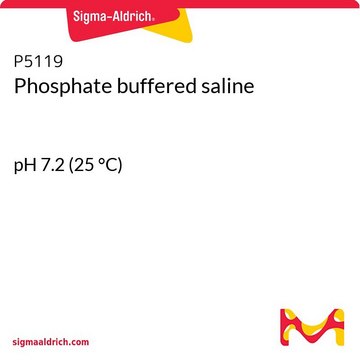806544
Phosphate Buffered Saline
pH 7.2, liquid, sterile-filtered, suitable for cell culture
Synonym(s):
Phosphate buffered saline, PBS
Sign Into View Organizational & Contract Pricing
All Photos(1)
About This Item
MDL number:
UNSPSC Code:
12352207
Recommended Products
sterility
sterile-filtered
form
liquid
technique(s)
cell culture | mammalian: suitable
impurities
Endotoxin, tested
pH
7.2
Looking for similar products? Visit Product Comparison Guide
General description
Phosphate-buffered saline (PBS) is a buffer solution used in biological research. It is a water-based salt solution containing sodium phosphate, sodium chloride and, in some formulations, it contains potassium chloride and potassium phosphate. The osmolality and ion concentrations of the solutions match those of the human body (isotonic) and are non-toxic to most cells.
Storage Class Code
12 - Non Combustible Liquids
WGK
nwg
Flash Point(F)
Not applicable
Flash Point(C)
Not applicable
Choose from one of the most recent versions:
Already Own This Product?
Find documentation for the products that you have recently purchased in the Document Library.
Weilun Fu et al.
Frontiers in oncology, 10, 78-78 (2020-03-03)
The tumor immune microenvironment (TIME) plays a pivotal role in tumor development, progression, and prognosis. However, the characteristics of the TIME in diffuse astrocytoma (DA) are still unclear. Leveraging mass cytometry with a panel of 33 markers, we analyzed the
Weilun Fu et al.
Frontiers in immunology, 11, 835-835 (2020-05-28)
The Glioblastoma (GBM) immune microenvironment plays a critical role in tumor development, progression, and prognosis. A comprehensive understanding of the intricate milieu and its interactions remains unclear, and single-cell analysis is crucially needed. Leveraging mass cytometry (CyTOF), we analyzed immunocytes
Tine Tesovnik et al.
Frontiers in cell and developmental biology, 8, 202-202 (2020-04-17)
Extracellular vesicles with their molecular cargo can modulate target cell response and may affect the pathogenesis of diseases. The extracellular vesicles containing micro-RNAs (miRNAs), which are often studied as disease biomarkers, but rarely as mediators of the disease development. The
Shriya S Srinivasan et al.
International journal of molecular sciences, 20(3) (2019-01-27)
Chemotherapeutic dosing, is largely based on the tolerance levels of toxicity today. Molecular imaging strategies can be leveraged to quantify DNA cytotoxicity and thereby serve as a theranostic tool to improve the efficacy of treatments. Methoxyamine-modified cyanine-7 (Cy7MX) is a
Garret Rochford et al.
Metallomics : integrated biometal science, 12(1), 65-78 (2019-11-14)
Herein we report an in-depth study on the cytotoxic mechanism of action of four developmental cytotoxic copper(ii) complexes: [Cu(phen)2]2+ (Cu-Phen); [Cu(DPQ)(Phen)]2+ (Cu-DPQ-Phen); [Cu(DPPZ)(Phen)]2+; and [Cu(DPPN)(Phen)]2+ (where Phen = 1,10-phenanthroline, DPQ = dipyrido[3,2-f:2',3'-h]quinoxaline, DPPZ = dipyrido[3,2-a:2',3'-c]phenazine, and DPPN = benzo[i]dipyrido[3,2-a:2',3'-c]phenazine). This
Our team of scientists has experience in all areas of research including Life Science, Material Science, Chemical Synthesis, Chromatography, Analytical and many others.
Contact Technical Service